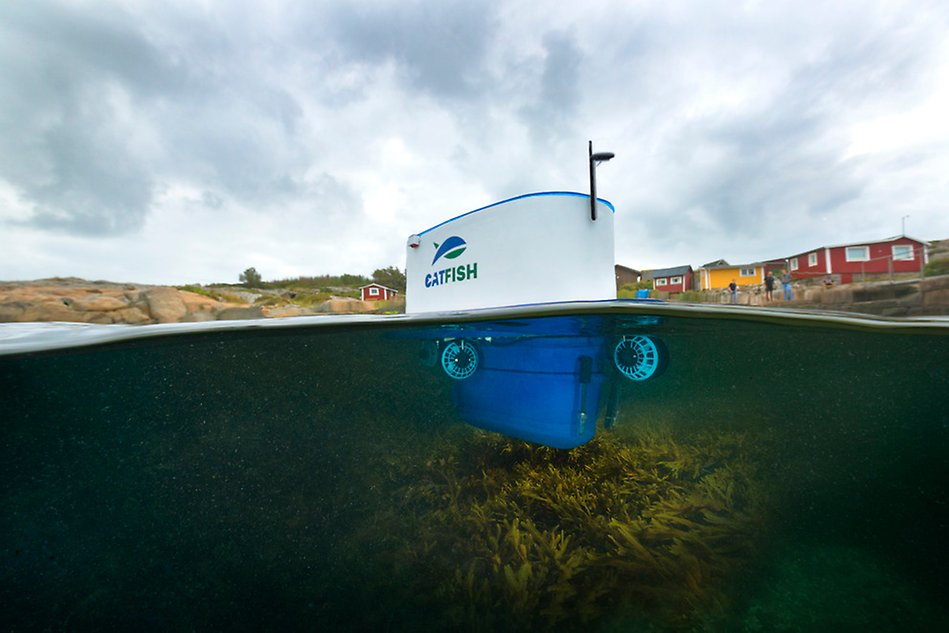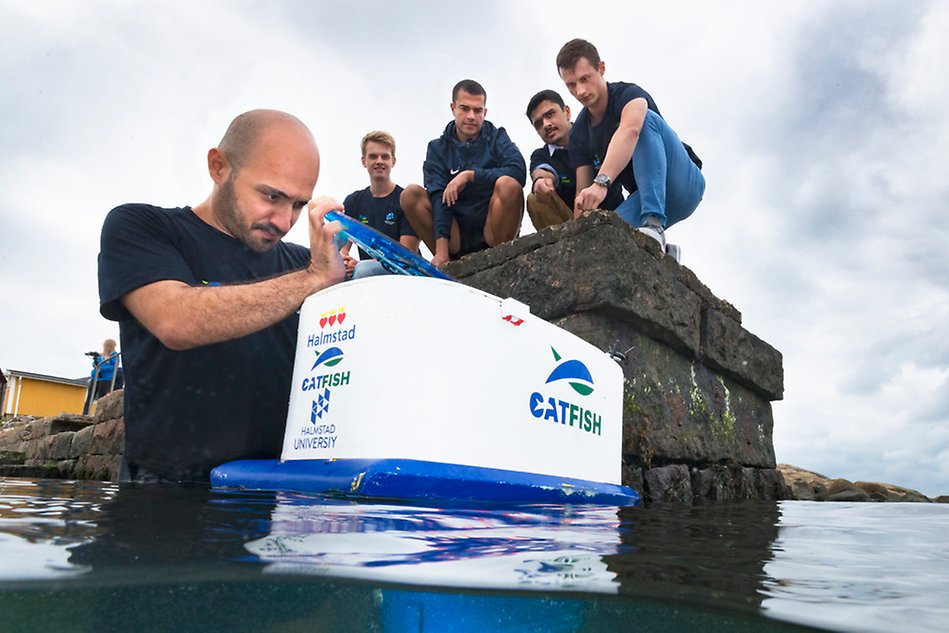Drone for clean water engages researchers and students
The CatFish project has gone from being a student project at the Master’s Programme in Industrial Innovation to becoming a research and collaboration project that engages researchers, students and external actors. It is based at the University’s newest collaboration arena Fab Lab Innovation.
”Nothing is impossible in this project. Students and researchers together push the boundaries and develop the technology of the future.”
Catherine Legrand, Professor of Marine Ecology
It was during the final year of their Master's programme that Alireza Esmaeilzadeh and Harvey Blanco, together with Joakim Tell, Associate Professor in Industrial Innovation, launched the idea of using a unmanned vessel drone to monitor and take samples from water bodies in real time. The water samples can then be analyzed to, for example, detect contaminants.
“The idea is to use drone technology to contribute to cleaner lakes, streams and coastal waters in a simple and efficient way. The CatFish system consists of three different drones: a flying one, a platform vessel that is situated on the water's surface, and an underwater drone that can dive and take samples in deeper water”, says Harvey Blanco. Alireza Esmaeilzadeh fills in:
“Our system simplifies the sampling process. With today's methods, it is resource-intensive to map water quality, because it often requires people to collect samples on site, and then bring them to a laboratory for analysis. In larger bodies of water, sampling can also be further complicated due to water quality varying over time, and therefore samples may need to be collected on several different occasions. By using drones, we can take samples and collect high-quality data in real time without any person having to be at the water body.”

With the help of real-time monitoring and the collected water samples, municipalities, county administrative boards and municipal companies responsible for water and water councils can better understand local water bodies, and thus also make better, more environmentally friendly decisions.
“There are many aspects that affect water quality. Agriculture, industries, traffic, and other activities contribute to an increase in sediment and nutrient leakage. Nutrients, such as phosphorus and nitrogen, that have leaked from fertilized fields, end up in the water. It contributes to eutrophication. To be able to remedy these problems, sharper analysis tools are required, and one such could be CatFish”, says Joakim Tell.
Collaboration recipe for success
CatFish is an example of how collaboration between different actors can take a project to the next level. The project has recently been granted funding from the Swedish Agency for Marine and Water Management, which works on behalf of the Government for the conservation, restoration and sustainable use of lakes, watercourses, the sea and fishery resources. The grant was applied for in collaboration with Halmstad Municipality, and the further work involves students and researchers from several of the University's schools. The County Administrative Board of Halland is also involved in the project.
”The University is extremely important to Halmstad, as it connects innovative people who together can find new solutions, for example when it comes to water and water management.”
Jonas Bergman, municipal board chairman
Just before the summer, students from several different educational programs presented no less than nine different degree projects, all of which were commissioned by CatFish and carried out with support from Fab Lab Innovation. Representatives from various water organizations, together with other actors, were present to take part of the results. One of the visitors was Jonas Bergman, chairman of the municipal board in Halmstad, who was very interested in the students' work as well as in the continued research in the area:
“The collaboration aspect is extremely important. It is fantastic when the University's researchers and students tackle real issues that the municipality need help solving. The University is extremely important to Halmstad, as it connects innovative people who together can find new solutions, for example when it comes to water and water management.

Contaminated water and inedible fish
Halmstad is known for its location on the coast and for the river Nissan which flows right through the city. The value of the water is obvious, and the signal is clear: Life in Halmstad is great, partly due to the constant proximity to water. Below the surface, however, things are a little different.
“The water in the river Nissan is actually quite polluted. It is not recommended to eat fish from the river. In the project, we will use the CatFish drone to measure the substances in the water and then recommend measures to reduce the number of pollutants”, says Joakim Tell.
Catherine Legrand, Professor of Marine Ecology, is involved in the project as well. She also returns to the added value that collaboration provides:
“When education and research are linked liked this, it creates synergies that are invaluable. CatFish brings together several different scientific disciplines, which is very valuable. In combination with the collaboration with other authorities on which the project is based, there are all the prerequisites for creating something interesting together.”
”We welcome students from all different disciplines, not just the technical ones. There is room for everyone, and everyone can contribute with important and exciting angles.”
Alireza Esmaeilzadeh, Lecturer
A project where all different disciplines are needed
With the start of the autumn term, a new cycle of the project starts. Just as last year, student collaboration is welcomed.
“We welcome students from all different disciplines, not just the technical ones. It would be very interesting to work, for example, with students from the fields of media and communication studies or from marketing. There is room for everyone, and everyone can contribute with important and exciting angles. We have established sixteen different ideas for projects, but if students come up with their own ideas, we can also help them realize those”, says Alireza Esmaeilzadeh.
“It is wonderful to see the students’ creativity. Their imagination sets the limits here. Nothing is impossible in this project. Students and researchers together push the boundaries and develop the technology of the future”, concludes Catherine Legrand.
Text: Christa Amnell
Photo: Patrik Leonardsson


